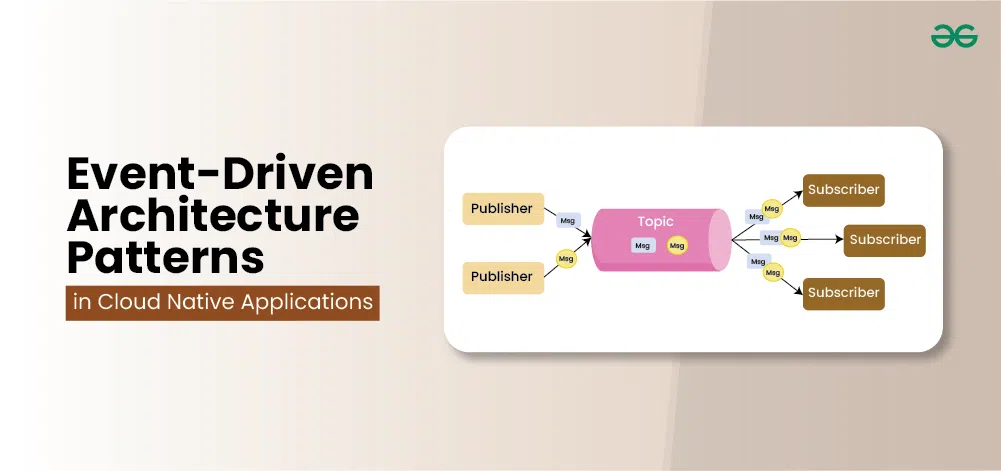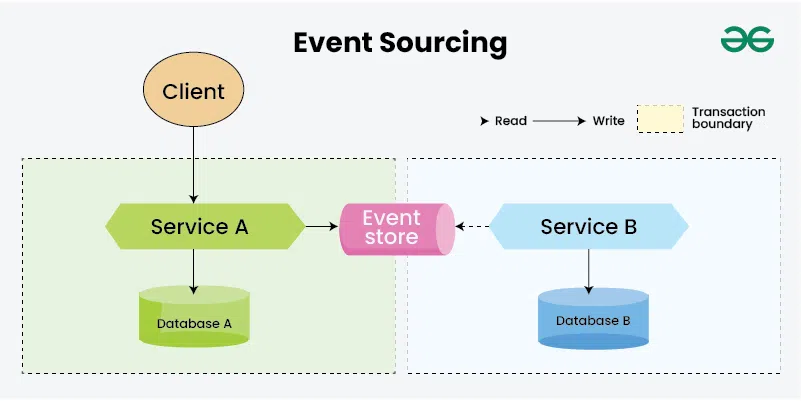Event-Driven Architecture Patterns in Cloud Native Applications
Last Updated :
23 Jul, 2025
Event-driven architecture (EDA) transforms cloud-native applications by enabling real-time responsiveness and scalability. This article explores key EDA patterns, their benefits in dynamic cloud environments, and practical strategies for implementing them to optimize performance and resilience.
 Event-Driven Architecture Patterns in Cloud Native Applications
Event-Driven Architecture Patterns in Cloud Native ApplicationsImportant Topics for Event-Driven Architecture Patterns in Cloud Native Applications
What is Event-Driven Architecture?
Event-driven architecture (EDA) is a design paradigm where systems react to events or changes in state rather than relying on a request-response model. In EDA, events are generated by various sources, and components or services respond asynchronously. This approach enhances scalability, flexibility, and responsiveness, making it well-suited for modern, distributed systems.
Importance of Event-Driven Architecture in Cloud Native Applications
Event-driven architecture (EDA) is crucial in cloud-native applications for several reasons:
- Scalability: EDA allows systems to handle varying loads efficiently by processing events asynchronously and distributing them across multiple services or instances, improving overall scalability.
- Responsiveness: It enables real-time data processing and immediate reaction to changes, which is essential for applications requiring prompt updates and interactions.
- Loose Coupling: By decoupling components through event streams, EDA fosters greater modularity and flexibility, allowing services to evolve independently without impacting other parts of the system.
- Fault Tolerance: EDA enhances resilience by isolating failures to specific services or events, preventing system-wide disruptions and improving overall reliability.
- Dynamic Scaling: Cloud-native environments benefit from EDA's ability to dynamically scale services up or down in response to the volume and frequency of events, optimizing resource usage and cost efficiency.
What are Event-Driven Architecture Patterns for Cloud-Native Applications?
Event-driven architecture (EDA) patterns for cloud-native applications are design paradigms that enable services to communicate and react to events asynchronously.
- These patterns facilitate the development of scalable, resilient, and loosely-coupled systems by defining how events are produced, transmitted, and consumed across distributed services.
- Key patterns include Publish-Subscribe, Message Queues, Event Sourcing, CQRS, Sagas, and Choreography, each addressing specific needs such as scalability, reliability, and responsiveness in cloud-native environments
Event-Delivery Patterns for Cloud Native Applications
Event-Delivery Patterns in cloud-native applications define how events are transmitted from producers to consumers, ensuring reliable and efficient communication across distributed systems. Below is an overview of key event-delivery patterns:
1. Publish-Subscribe (Pub-Sub):
- In a Pub-Sub system, events are published to a topic or channel, and multiple subscribers can receive those events. Publishers are unaware of the subscribers, and subscribers are unaware of the publishers.
- In Cloud-Native Applications:
- Decoupling: Services can independently publish events and subscribe to events from other services. For example, a user activity service might publish user actions (like login or purchase), and other services such as analytics or notification services can subscribe to these events without direct dependencies.
- Scalability: Pub-Sub systems like Apache Kafka or AWS SNS can handle a high volume of events and distribute them across many subscribers, allowing cloud-native applications to scale efficiently.
 Publish-Subscribe (Pub-Sub)
Publish-Subscribe (Pub-Sub)The diagram illustrates the Pub-Sub pattern, where events are published by publishers and received by multiple subscribers. This decoupled communication pattern enhances flexibility in application architecture.
2. Message Queue:
- A message queue temporarily holds messages that need to be processed by different services. Consumers pull messages from the queue and process them asynchronously.
- In Cloud-Native Applications:
- Reliability: Ensures that messages are not lost and can be processed later, which is crucial in distributed systems where services may have varying loads and availability. For instance, RabbitMQ can manage tasks like order processing, ensuring that even if a service goes down, messages are not lost.
- Decoupling and Load Balancing: Helps in balancing the load across multiple consumers and allows for asynchronous processing. Services producing events do not need to wait for the processing to complete, improving overall system responsiveness.
 Message Queue
Message QueueThe diagram depicts a Message Queue pattern where messages are queued and delivered to consumers. This asynchronous approach ensures scalability and reliability in event processing.
State Management Patterns for Cloud Native Applications
State Management Patterns in cloud-native applications focus on how state is stored, managed, and updated in distributed systems. Here’s an overview of key state management patterns:
- Instead of storing the current state, event sourcing involves recording all changes as a series of events. The application’s state can be reconstructed by replaying these events.
- In Cloud-Native Applications:
- Complete History: Provides a full audit trail of changes, which is valuable for compliance and debugging. For instance, an e-commerce system can track every change to an order or inventory, allowing for precise tracking of the state and historical data.
- Flexibility: Enables powerful features like replaying events to reconstruct state or to apply changes retrospectively. This is useful for building features like undo or aggregating data for reporting purposes.
 Event Sourcing
Event SourcingThe diagram showcases Event Sourcing, where events are stored and used to reconstruct the application's state. It provides a historical view of all actions, facilitating data consistency.
2. CQRS (Command Query Responsibility Segregation):
- CQRS separates the operations that modify data (commands) from those that read data (queries). Commands update the state, while queries retrieve data.
- In Cloud-Native Applications:
- Performance Optimization: Commands and queries can be optimized and scaled independently. For instance, a high-traffic e-commerce site might scale its read operations separately from write operations to handle search and browsing efficiently without affecting order processing.
- Security and Flexibility: Different security measures and performance optimizations can be applied to commands and queries, such as enforcing stricter access controls on commands that modify data.
 CQRS (Command Query Responsibility Segregation)
CQRS (Command Query Responsibility Segregation)The diagram illustrates CQRS, which divides command and query responsibilities. This separation optimizes performance and scalability by enabling independent scaling of components.
Orchestration Patterns for Cloud Native Applications
Orchestration patterns in event-driven architecture define how events are coordinated and managed across multiple services in cloud-native applications. Below is an overview of key orchestration patterns:
1. Saga:
- A saga manages a long-running transaction by breaking it into smaller, isolated transactions that can be coordinated and rolled back if necessary. Each transaction has a corresponding compensating action to handle failures.
- In Cloud-Native Applications:
- Distributed Transactions: Useful for managing complex workflows involving multiple microservices. For example, in a booking system, a saga might manage the booking of flights, hotels, and car rentals, ensuring that if one step fails, previous steps are rolled back to maintain consistency.
- Resilience: Provides a way to handle failures gracefully across distributed services, improving the overall reliability of the system.
 Saga Pattern
Saga PatternThe diagram presents a Saga pattern, showcasing a sequence of events and actions across microservices. Sagas enable distributed transaction management for data consistency.
2. Choreography:
In choreography, microservices react to events independently, without a central orchestrator. Each service listens for relevant events and performs actions based on those events.
- In Cloud-Native Applications:
- Decentralization: Services operate autonomously, leading to a more flexible and adaptable system. For example, in a supply chain application, each service (inventory, shipping, billing) might react to inventory changes independently, without needing a central controller.
- Adaptability: Services can evolve and change independently as they only need to adhere to the event schema, making it easier to update or replace services.
 Choreography
ChoreographyThe diagram demonstrates Choreography, where microservices communicate through events without central coordination. This approach offers flexibility and autonomous service evolution.
Technologies for Event-Driven Architecture in Cloud-Native Applications
There are several technologies that support Event-Driven Architecture in Cloud Native Applications:
- Apache Kafka: A distributed streaming platform that provides high-throughput, low-latency event streaming. It is ideal for handling large volumes of events and ensuring reliable delivery across cloud-native applications.
- RabbitMQ: A message broker that supports various messaging protocols and ensures reliable delivery of messages between services. It’s useful for implementing message queues and Pub-Sub systems.
- AWS Lambda: A serverless computing service that can execute code in response to events, such as changes to data or messages in a queue. It enables scalable and cost-effective event-driven processing.
- Kubernetes: Manages containerized applications and orchestrates microservices, providing the infrastructure needed to deploy and scale event-driven applications effectively in a cloud environment.
Challenges and Considerations for Event-Driven Architecture in Cloud-Native Applications
Below are the challenges and considerations for event-driven architecture in cloud-native applications:
- Complexity: Designing and managing asynchronous services can be intricate. Ensure clear event schemas and robust documentation.
- Event Ordering and Consistency: Events might arrive out of order or be duplicated. Implement idempotency and order management mechanisms.
- Debugging and Troubleshooting: Asynchronous systems complicate issue resolution. Use comprehensive logging, monitoring, and distributed tracing.
- Scalability and Performance: Handling high volumes of events requires scalable infrastructure. Use efficient event streaming platforms and manage resources effectively.
- Data Management and Storage: Storing large volumes of events can be resource-intensive. Implement efficient storage solutions and manage data retention.
- Security and Compliance: Protect event data with encryption and access controls. Ensure compliance with relevant regulations.
- Handling Failure and Reliability: Ensure the system can recover from failures. Use retry logic and dead letter queues for failed messages.
Conclusion
Event-Driven Architecture (EDA) is crucial for optimizing cloud-native applications, providing scalability, flexibility, and responsiveness. By utilizing patterns like Publish-Subscribe, Message Queues, Event Sourcing, CQRS, Sagas, and Choreography, systems can handle complex workflows and adapt to dynamic requirements effectively. Despite its advantages, EDA presents challenges such as complexity, event ordering, and debugging. Addressing these through robust design, proper tooling, and effective testing ensures that cloud-native applications can fully leverage EDA's benefits while maintaining performance, reliability, and security.
Explore
What is System Design
System Design Fundamentals
Scalability in System Design
Databases in Designing Systems
High Level Design(HLD)
Low Level Design(LLD)
Design Patterns
Interview Guide for System Design
System Design Interview Questions & Answers